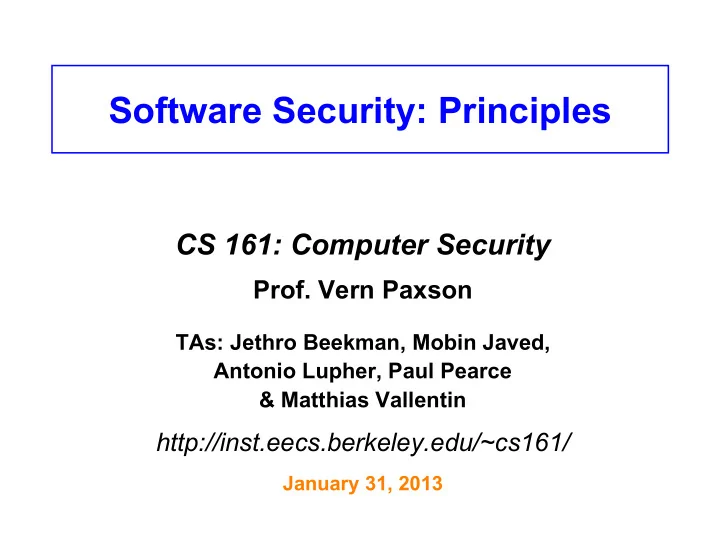

Software Security: Principles CS 161: Computer Security Prof. Vern Paxson TAs: Jethro Beekman, Mobin Javed, Antonio Lupher, Paul Pearce & Matthias Vallentin http://inst.eecs.berkeley.edu/~cs161/ January 31, 2013
TL-‑15
TL-‑30
TRTL-‑30
TXTL-‑60
“Security is economics.”
What ¡does ¡this ¡program ¡do?
What ¡ can ¡this ¡program ¡do? Can ¡it ¡delete ¡all ¡of ¡your ¡files? YES. ¡ ¡Why?
“Least privilege.”
Touchstones for Least Privilege • When assessing the security of a system’s design, identify the Trusted Computing Base ( TCB ). – What components does security rely upon? • Security requires that the TCB: – Is correct – Is complete (can’t be bypassed) – Is itself secure (can’t be tampered with) • Best way to be assured of correctness and its security? – KISS = Keep It Simple, Stupid! – Generally, Simple = Small • One powerful design approach: privilege separation – Isolate privileged operations to as small a component as possible – (See lecture notes for more discussion)
“Ensure complete mediation.”
Ensuring Complete Mediation • To secure access to some capability/resource, construct a reference monitor • Single point through which all access must occur – E.g.: a network firewall • Desired properties: – Un-bypassable (“complete mediation”) – Tamper-proof – Verifiable – (Note, just restatements of what we want for TCBs) • One subtle form of reference monitor flaw concerns race conditions …
TOCTTOU Vulnerability ¡procedure ¡withdrawal(w) ¡ ¡ ¡ ¡// ¡contact ¡central ¡server ¡to ¡get ¡balance ¡ ¡ ¡ ¡1. ¡let ¡b ¡:= ¡balance ¡ ¡ ¡ ¡ ¡ ¡ ¡ ¡2. ¡if ¡b ¡< ¡w, ¡abort ¡ ¡ ¡ ¡// ¡contact ¡server ¡to ¡set ¡balance ¡ ¡ ¡ ¡3. ¡set ¡balance ¡:= ¡b ¡-‑ ¡w ¡ ¡ ¡ ¡4. ¡dispense ¡$w ¡to ¡user TOCTTOU = Time of Check To Time of Use
¡public ¡void ¡buyItem(Account ¡buyer, ¡Item ¡item) ¡{ ¡ ¡ ¡ ¡if ¡(item.cost ¡> ¡buyer.balance) ¡ ¡ ¡ ¡ ¡ ¡return; ¡ ¡ ¡ ¡buyer.possessions.put(item); ¡ ¡ ¡ ¡buyer.possessionsUpdated(); ¡ ¡ ¡ ¡buyer.balance ¡-‑= ¡item.cost; ¡ ¡ ¡ ¡buyer.balanceUpdated(); ¡ ¡}
“Separation of responsibility.”
5 Minute Break Questions Before We Proceed?
“Defense in depth.”
“Company ¡policy: ¡passwords ¡must ¡be ¡at ¡least ¡10 characters ¡long, ¡contain ¡at ¡least ¡2 ¡digits, ¡1 uppercase ¡character, ¡ ¡1 ¡lowercase ¡character, ¡and 1 ¡special ¡character.”
TC-‑0
What a piece of work is a man! how Noble in Reason! how infinite in faculty! in form and moving how express and admirable! in Action, how like an Angel! in apprehension, how like a God! -- Hamlet Act II, Scene II “Humans are incapable of securely storing high-quality cryptographic keys, and they have unacceptable speed and accuracy when performing cryptographic operations. (They are also large, expensive to maintain, difficult to manage, and they pollute the environment. It is astonishing that these devices continue to be manufactured and deployed. But they are sufficiently pervasive that we must design our protocols around their limitations.)” -- Network Security: Private Communication in a Public World , Charlie Kaufman, Radia Perlman, & Mike Speciner, 1995
“Psychological acceptability.”
“Consider human factors.”
“Threat models change.”
“Threat models change.” “Design security in from the start.” (Beware bolt-on security .)
“Don’t rely on security through obscurity.”
“Trusted path.”
Soda ¡Hall ¡wiring ¡closet
Protection?
“Use fail-safe defaults.”
Recommend
More recommend